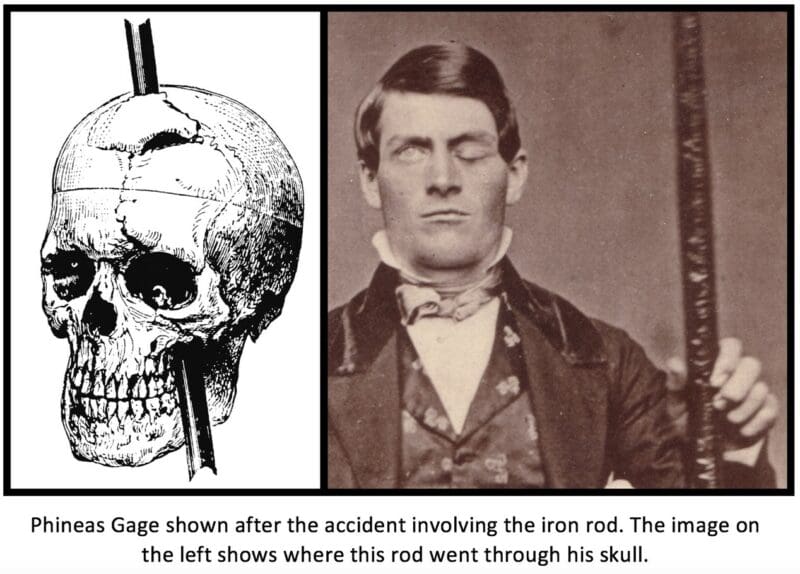In this post
You may have already heard of Phineas Gage, such is his infamous history with psychology. He was working on a railway line in the USA when there was an explosion, which resulted in an iron rod being fired through his head. He survived the accident even though there were serious injuries to his face and brain but it was soon discovered that in terms of his personality, he was completely different after the accident than he was before it.

Before the accident he was described as a very calm man who was very popular, but afterwards he was considered to be rude and irresponsible.
Gage died 12 years after the accident and after hearing of his death, his doctor, John Harlow, who had worked with him at the time of his accident, asked for his body to be exhumed so that he could look at his skull and try to identify how this caused the change in his personality.
Many years later, Damasio and her colleagues were able to make use of much better technology to further investigate the damage that had been caused to Phineas Gage’s brain and the effects that this had on his personality.
Aim
Damasio et al. aimed to build a replica model of Gage’s skull (using the actual skull as a guide) so that they could show exactly where the iron rod entered and exited Gage’s head.
A 3D representation of the skull and the injuries it received meant that it was much clearer which parts of his brain would have been affected by the accident and Damasio et al. wanted to see if any other areas of the brain had also been damaged.
Method
- Pictures and measurements of Gage’s skull were taken
- A 3D replica model was built based on the information from the skull
- Information was also taken from the iron rod (which had been buried with Gage!)
- Information from the rod and the skull together meant that the trajectory of the iron rod could be accurately mapped
- Altogether 20 different points of entry and 16 points of exit were identified and the five most likely paths were chosen
- Each of these five paths were explored to map out which areas of Gage’s brain would have been damaged by each path.
Results
It was thought that damage to both the left and right hemispheres of the brain were likely and that no other area than the frontal lobe would have been affected.
The iron rod would have gone through Gage’s left eye socket and then upwards in its trajectory. This means that rather than affecting the right frontal lobe, only the white matter (tissue containing nerve fibres) in the brain’s left hemisphere would have been affected. However, this meant that neural messages in this area of the brain would not have been transmitted because white matter is where neurons pass messages along axon fibres.
Conclusion
The findings from the 3D model and its implications for the parts of the brain that were thought to be damaged were compared to reports of the changes in Gage’s personality. It was concluded that a specific area of the frontal lobe (the ventromedial area) is responsible for making controlled decisions, regulating impulses and urges and dealing with emotions in a proper way.
These findings were compared to 12 other individuals who had experienced similar brain injuries and the same problems with control and impulse were found, showing that it is likely possible to predict the behaviour of people who have sustained this kind of brain injury.
Strengths of the study
- Modern-day technology is very reliable and therefore the 3D model that was created would have been very accurate and information could be ‘seen’ rather than just guessed at from written reports
- Predictions can now be made about people’s behaviour when they have experienced injuries in specific areas of the brain; this can help people to adjust to new lifestyles and may help in treating them as well.
Weaknesses of the study
- Information about the change in Gage’s personality were gleaned from details written more than a century ago, meaning its accuracy is questionable
- As this was a case study, it is difficult to generalise the findings to a wider population so predictions about possible changes in behaviour may not be applicable to everyone.



